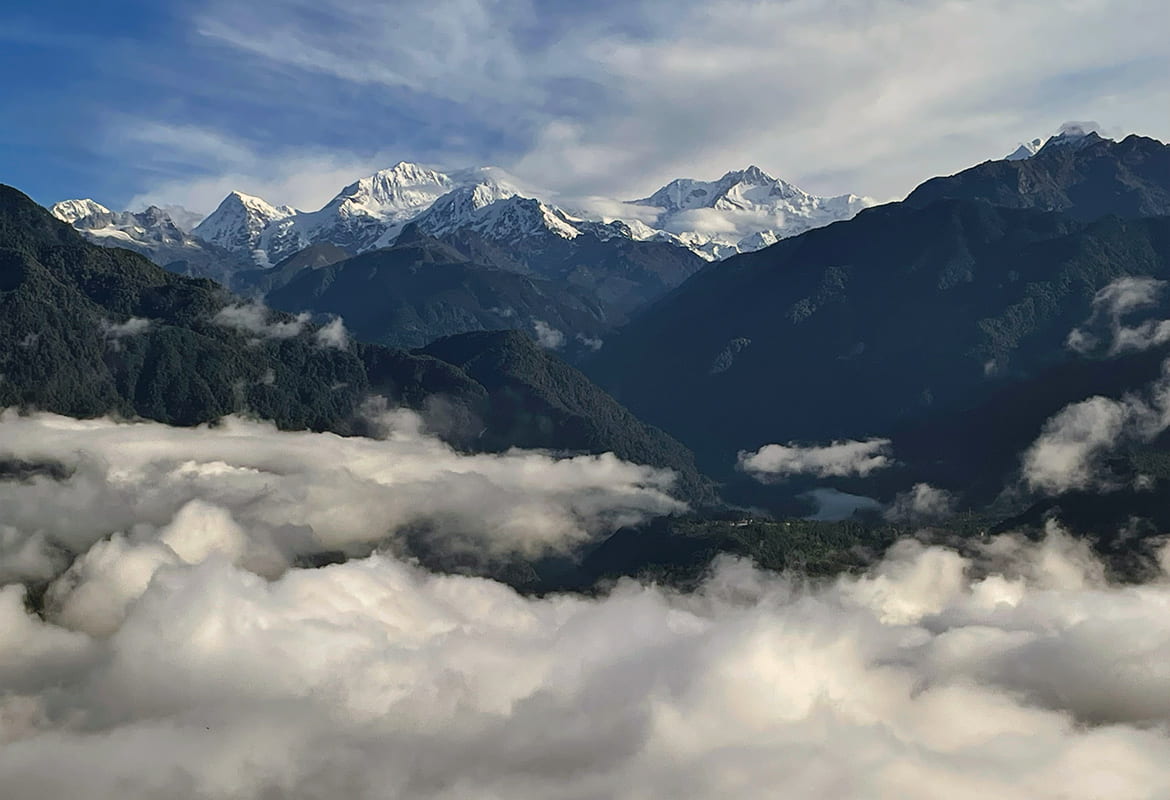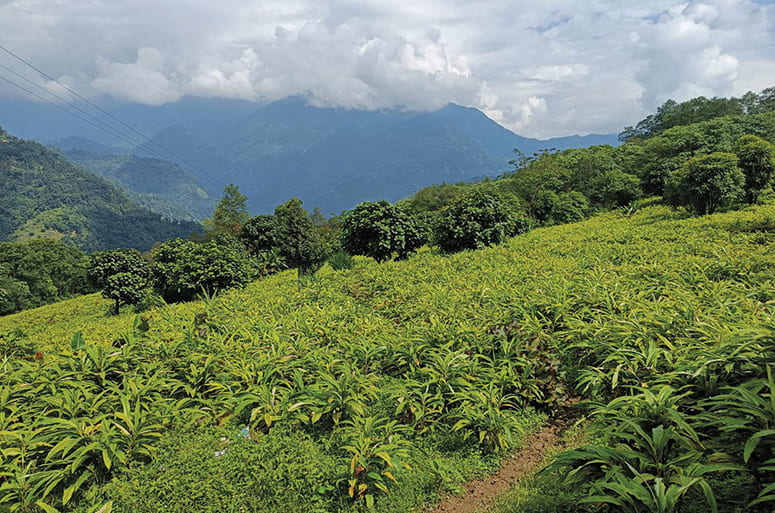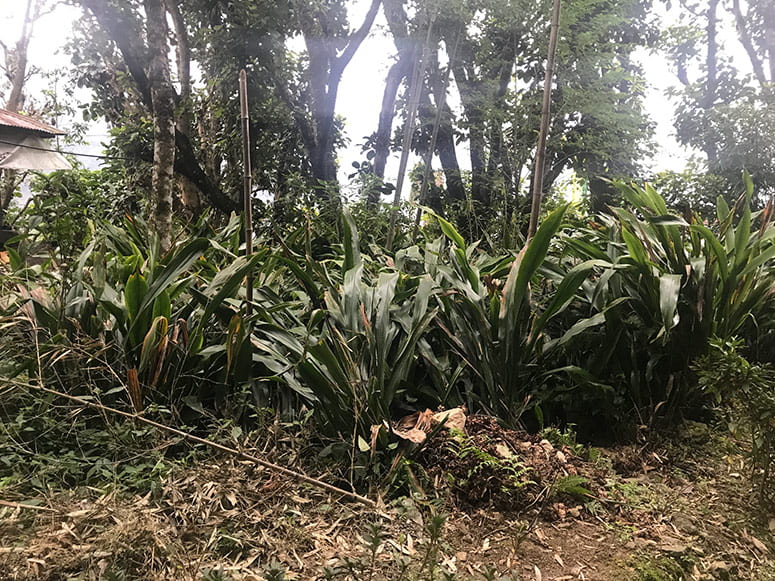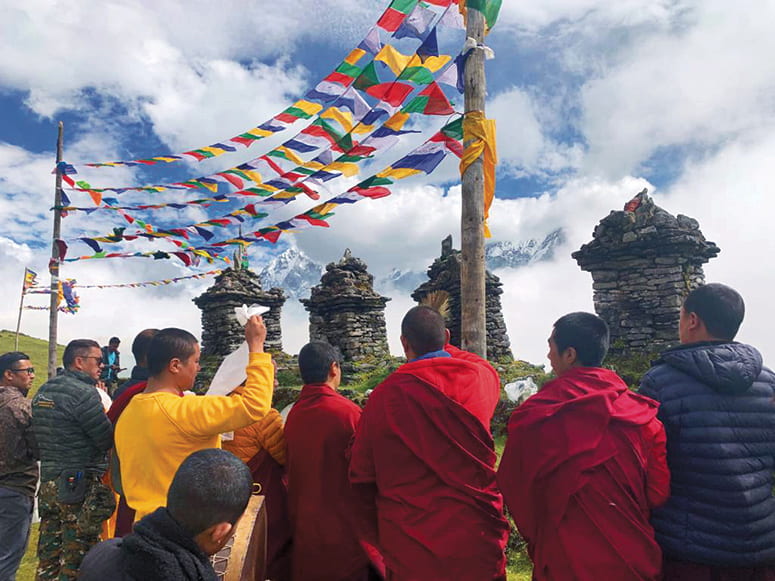
Featured
Caring for the Warming Valley of Abundance in West Sikkim, India
Connecting cardamom and prosperity in Sikkimese cosmologies.
Kanchendzonga, 2022. Kalzang Dorjee Bhutia
By Kalzang Dorjee Bhutia
The small northeastern Indian state of Sikkim is one of the largest producers of large cardamom in the world. This precious spice, used in a variety of cuisines, is exported from India to markets around the globe. Cardamom is a significant export from Sikkim, as it is the main cash crop in the state.
The association between the spice and prosperity has a deep resonance in Sikkimese Indigenous and Buddhist ritual lifeways and religion. In local oral traditions, large black cardamom (Amomum subulatum) is considered to be a native crop that has been planted in the hills and valleys of Sikkim since time immemorial. But it was only in the nineteenth century that cardamom began to be planted as a cash crop in West Sikkim, and later, by the early twentieth century, in North Sikkim. This shift toward the introduction of mass planting came in response to a global demand from imperial markets. In contemporary Sikkim, the majority of the population still depends on agriculture for their livelihood; thus, the fortunes of cardamom are closely intertwined with the well-being of Sikkim’s human residents.
These fortunes, however, are not only considered in terms of the value of cardamom simply as a commodity. Understanding cardamom only as a commodity reflects a move away from how Sikkimese communities historically interacted with, and thought about, the spice. Among the Lepcha, the first Indigenous people of Sikkim, cardamom was used in herbal medicine. Lepcha bongthings, the ritual practitioners and herbal doctors of the community, continue today to propitiate Lenji Nikung, a grandmother deity who cares for lenji (the Rong word for cardamom), to ensure the abundance and well-being not just of the plants but also of the human communities who tend to them.1

Cardamom field, western Sikkim, 2022. Kalzang Dorjee Bhutia
Among the Buddhists in both the Bhutia and Lepcha ethnic communities in western Sikkim, cardamom is offered, with other crops, to the protector deity Mount Kanchendzonga and to one of his accompanying mountain deities, Mount Mon Drepung, during Pang Lhabsol, the mountain propitiation ceremony, and again during the autumn harvest time.2 These offerings acknowledge the reciprocity between the humans who harvest the cardamom, the other powerful unseen beings of the land, and the cardamom itself, which is an agent in this enchanted landscape. Early Tibetan Buddhist visitors to the region discussed the fertility and abundance of the land. In a guidebook revealing Sikkim’s sacred geography, the Tibetan yogi Rigdzin Godemchen (1450–1521), described Sikkim as a land of abundance—or, as it was called in all the Treasure texts that followed, the Hidden Valley of Rice, Beyul Demojong.
In the lower part of the Hidden Valley in three areas, crops grow without being sown; in the middle part of the valley in three areas, barley grows without being sown; in the upper part of the valley, there are four places where buckwheat grows without being sown. There are numerous varieties of nutritious fruit present in the valley, with one hundred and twenty-five tastes.3
While this passage does not mention cardamom specifically, local communities include cardamom as one of the fruits described in this guidebook and in other materia medica texts. In Rai communities, oral traditions consider cardamom, ginger, and basil to be three plants that bring health, safety, and prosperity into the home.4 In Sikkim, these cosmologies are not separate but instead reflect what anthropologist Charisma Lepcha has referred to as the complex layers of Sikkim’s multicultural landscapes and histories.5
These are but three examples of many more. Throughout all these different, multicultural layers, cardamom is a crop associated with well-being and prosperity that stretches beyond its value in capitalist economies. Its flourishing is an eastern Himalayan representation of the abundance Candace Fujikane discusses in her work on Hawai’ian cosmologies of abundance, Mapping Abundance for a Planetary Future. Fujikane argues for the importance of recognizing abundance as a concept beyond economies of extraction, and how this recognition can encourage reciprocity and new forms of relatedness with the land.6
Multispecies Justice and the Cardamom Blight
How this recognition of abundance might look in Sikkim’s multilayered landscape is complicated, especially when cardamom is the leading cash crop in Sikkim, together with ginger and oranges. Since the turn of the twenty-first century, the cardamom plant in Sikkim has been devastated by a fungal leaf blight, which has led to a severe decline in cardamom production and has greatly impacted the agricultural communities that are dependent on the cardamom crop.7
This fungal disease has been attributed to several causes, but the overarching belief held by both scientists and farmers is that it is connected to rising temperatures and other local manifestations of the effects of global warming. For local communities, the suffering of cardamom is painfully connected with the suffering of the human communities whose livelihoods are impacted by the blight. In my research, I explore how local Buddhist human communities understand, discuss, and respond to environmental changes in western Sikkim. For these Buddhist communities, understanding of, and anxieties about, climate change are often connected with human morality and behavior. In my home village and in the surrounding areas, where our predominant source of income is cardamom, the cardamom blight is discussed in terms of warming soil, but it is also attributed to human interventions in the landscape that are motivated by greed and by a lack of understanding about the interconnectedness that both Buddhist and Indigenous cosmologies see as fundamental to human-environment relations.
As a result, the farmers of West Sikkim have taken on a variety of initiatives and experiments to respond to the increasing periods of drought. These initiatives have included practical changes, such as experimenting with new distribution patterns for irrigation and watering, or transplanting cardamom seedlings grown from other, disease-free plants brought from elsewhere in the state.

Cardamom plants with blight, western Sikkim, 2022. Kalzang Dorjee Bhutia
Some of these experiments have been undertaken with guidance from state-level institutions, such as the Spice Board of India, or from scientists coming to conduct research in the area. Other initiatives, however, reflect the long-standing relationship between farmers and their lands, which have led them to draw upon the traditional and historical knowledge of agriculture. These farmers have been driven by necessity. Many of the people I spoke to, including family members, reported that visiting scientists rarely follow up with their findings, and so they have been left to speculate and experiment themselves. This represents another example of the marginalization of local discourse from climate change policy, which Ritodhi Chakraborty and Pasang Sherpa have written about.8 Many of these experiments initiated locally have been successful, at least temporarily. However, the blight remains, and the erratic rainfall patterns that still disrupt Sikkim’s seasonal cycle also continue to impact cardamom harvests.
Local knowledge and understanding of cardamom have undoubtedly offered an advantage in the response to the real economic challenges the blight has brought. This knowledge is undergirded by the various forms of connection different Sikkimese cosmologies emphasize. These broader understandings of the agency of cardamom, not only as a tasty, nutritious treat but also as a fellow member of the sacred landscape, are significant in changing how people today can reconceptualize their relationships with the crops of Sikkim, from ways that center on extraction alone and instead point to a future built upon a system of multispecies justice.9
Local knowledge and understanding of cardamom have undoubtedly offered an advantage in the response to the real economic challenges the blight has brought.
The challenge posed by centering cardamom as an agent arises from the ways that local cosmologies have become tied to ethnopolitics and ethnonationalist projects. In recent years, the sacred geographies of the Himalayas have been critiqued as part of ethnonationalist projects that affix narrow, normative concepts of identity to belonging in different regions. In many parts of the Himalayas, these narrow concepts of identity are especially concerning, given the many challenges brought by climate change and by state-level developmental agendas that have contributed to population displacement, disasters, and illness among human and nonhuman populations.10 Among local communities in Sikkim, Indigenous and Buddhist narratives have provided powerful visions for an environmental ethics that has inspired activist movements, particularly against destructive hydroelectric projects.
The downside to the centrality of these narratives, however, has been their connection to ethnopolitics. The anthropologist Mona Chettri has written about the dangers of the Buddhacization of the sacred landscape, which marginalizes non-Buddhist human communities who are also suffering from the brunt of the destruction brought about by these ethnopolitical initiatives.11 In her research on cardamom in northern Sikkim, geographer Mabel Gergan has demonstrated how connecting cardamom blight with morality has led to the scapegoating of Nepali laborers by Lepcha farmers, despite the historical coexistence of both communities, which worked together and engaged in ritual propitiation together. Gergan urges her readers to engage with these narratives critically, as they represent how those same lifeworlds that may provide “flexibility and room for adaptation” can also become “rigid and insular” when faced with the existential precarity of climate change. It is, therefore, crucial to remember how “coexistence and collaboration can be negotiated” in the making of new, just futures in the mountains.12 These new futures challenge representations of decline and disruption. As Potawatomi environmental justice scholar Kyle Whyte has pointed out, narratives of the destruction and precarity brought by climate change can all too often marginalize Indigenous experience and understanding of relatedness. Whyte argues against “crisis epistemologies” and for “epistemologies of coordination.”13
Cardamom Harvest Rituals: Relatedness and Reciprocity
Overshadowing any argument for a singular narrative that marginalizes or erases different communities, I believe, is the fact that relatedness is at the center of these different ways of knowing cardamom. And relatedness is key to recognizing that any shared, coordinated effort to address the cardamom blight transcends all specific ethnic communities or religious cosmologies. What might this relatedness look like?
Across the different religious cosmologies of Sikkim, relatedness is invoked in multiple ways. Many western Sikkimese farmers have shared with me about the cooperation engaged in across different communities and localities in their attempts to deal with the blight. This coordination has taken a variety of forms. The first is the sharing of local knowledge and information about ways to respond. Min Bahadur Gurung, Surendra Raj Joshi, and Harish Chilwal Chandra have discussed how farmers have been using social media, including WhatsApp and Facebook, to share ideas about different strategies they might try to prevent the blight from attacking their crops.14 Social media is simply a another form of “word of mouth,” which is also common.
Another form coordinated effort has taken is in western Sikkim, where cardamom is planted using reciprocal labor: farmers and villagers will take turns working in different fields other than their own and then will return the favor when it comes time for their own planting and harvest. This reciprocity means that new strategies and information is circulated widely within localities. One example of an effective strategy that spread through reciprocal labor was the planting of cardamom in locations where there had previously been other crops, such as maize and other household vegetables. Farmers related to me that this sort of crop rotation meant that the soil contained different nutrients, which then led to successful yields.
Even as new solutions are found, new challenges have arisen. Rising temperatures have led to the arrival of new predators of cardamom. In the past, monkeys and civets did not reside in the valleys of western Sikkim, because of the temperatures. However, the animals have gradually left their previous habitats and climbed to higher altitudes, and this has meant more conflict with humans, since both monkeys and civets find the cardamom fruit to be delicious. Unlike boars and bears, who tend to destroy only the upper foliage of the cardamom plant in their foraging for food, civets can actually peel open the cardamom and eat the ripe inner fruit, and monkeys split open the plants before they are even ripe and eat the soft tissue inside, leaving farmers with nothing to harvest. Farmers have tried a number of different means to ward off these competing cardamom consumers, including employing guards who play loud music and throw stones.

Pang Lhabsol offerings at Kanchendzonga base camp, 2021. Chopel Dorjee Bhutia
A number of ritual traditions that have promoted forms of relatedness in the protection of cardamom are also followed. One creative traditional method is the use of burned offerings, or sang, made up of cuttings from the forest.15 Another is the ritual undertaken at Pang Lhabsol, a ceremony that takes place during the twelfth and fifteenth days of the seventh month of the lunar calendar. This ceremony is known today for its dramatic ritual dance, in which young men dressed as warriors perform the Pangtod Cham as the culmination of a ritual offering to Kanchendzonga: the vows the Lepcha and Bhutia communities made to live together in a “blood brotherhood” are reinvigorated, and the mountain, as the witness of the vow, is recognized as an inextricable part of this relationship. However, Pang Lhabsol is not all about ritual dances. In important ceremonies carried out on the slopes of Kanchendzonga, lamas and laypeople come together to offer Kanchendzonga and the other deities of Sikkim portions of their crops, especially cardamom, which has just been harvested. This offering functions as a powerful acknowledgement of the crucial ties between humans and nonhumans that make it possible for all beings to flourish in the Valley of Rice. Part of this ritual also functions as an apology for human environmental destruction and wrongdoing.16
The Pang Lhabsol observance is one of many that acknowledge the relatedness and connectedness between the human and nonhuman inhabitants of Sikkim. While it is a ritual that arose during a specific time and in a specific place, in recognition of the historical processes of human habitation of the region, it is also a ritual that focuses on the mountain and the land. This remembering through ritual recognition functions as vibrant inspiration for human communities to conceive of the land in a nonextractive way.
At the local level, cardamom farmers live this understanding of the land every day. In my village, my brother and the neighboring farmers see their prosperity as an obligation to maintain good relations with the broader ecosystems that make cardamom grow so well on their land. For my brother, this obligation manifests as a tireless concern for the well-being of the cardamom, and for the soil and water that nourishes it, and in a sense of reciprocity that compels him to make burned smoke and food offerings and prayers before he undertakes his planting and harvest and that requires him to engage in a planting cycle that avoids overwhelming the land. When he meets monkeys and civets, rather than attacking them as predators, he understands them to be manifestations of local dharma protectors (in the Bhutia language, these are known as chökyong yullha zhidak), and their appearance to be indicative of wider environmental imbalance, which is not of their making. Coordination, cooperation, and care provide him and other farmers with alternative visions for just futures in the mountains that are not based on extraction but instead on reciprocity and repair across species, including plants, deities, humans, monkeys, civets, and all those unseen.
Notes:
- See Mabel Gergan, “Loss and Recovery in the Himalayas: Climate-Change Anxieties and the Case of Large Cardamom in North Sikkim,” in Understanding Climate Change through Religious Lifeworlds, ed. David Haberman (Indiana University Press, 2021), 219.
- For more on Pang Lhabsol, see Kalzang Dorjee Bhutia, “Living with the Mountain: Mountain Propitiation Rituals in the Making of Human-Environmental Ethics in Sikkim,” Journal of Buddhist Ethics 28 (2021): 261–94.
- My translation of Pema Lingpa, in Mkha’ spyod ’bras ljongs kyi gnas yig phyogs bsdebs bzhugs, ed. Tashi Tsering (Namgyal Institute of Tibetology and Amnye Machen Institute, 2008), 250.
- Shruti Rai, “Dyanmics of Oral Traditions among Rai Communities of Sikkim” (MPhil diss., Sikkim University, 2020), 65–66.
- Charisma Lepcha, personal communication, 2022.
- Candace Fujikane, Mapping Abundance for a Planetary Future (Duke University Press, 2021).
- For more on the blight, see Kabita Gurung et al., “Curvularia eragrostidis, a New Threat to Large Cardamom (Amomum subulatum Roxb.) Causing Leaf Blight in Sikkim,” Journal of Biosciences 45, no. 113 (2020): 1–8.
- Ritodhi Chakraborty and Pasang Yangyee Sherpa, “From Climate Adaptation to Climate Justice: Critical Reflections on the IPCC and Himalayan Climate Knowledges,” Climatic Change 167 (2021). doi.org/10.1007/s10584-021-03158-1
- Sophie Chao, “Can there Be Justice Here?: Indigenous Perspectives from the West Papuan Oil Palm Frontier,” Borderlands 20, no. 1 (2021): 11–48.
- Many climate change impacts are discussed in Climate Change in Sikkim: Patterns, Impacts and Initiatives, ed. M. L. Arrawatia and Sandeep Tambe (Information and Publication Relations Department, Government of Sikkim, 2012). Note, however, that this volume was sponsored by the Government of Sikkim so should be used with caution.
- Mona Chettri, “Ethnic Environmentalism in the Eastern Himalaya,” Economic and Political Weekly, 52, no. 46 (2017): 34–40.
- Gergan, “Loss and Recovery in the Himalayas,” 225, 226.
- Kyle Whyte, “Against Crisis Epistemology,” in Handbook of Critical Indigenous Studies, ed. Brendan Hokowhitu et al. (Routledge, 2021), 52–64.
- Min Bahadur Gurung, Surendra Raj Joshi, and Harish Chilwal Chandra, “Building Resilience through Cardamom,” ICIMOD, November 25, 2017.
- For more on sang in Sikkim, see Kalzang Dorjee Bhutia, “Purifying Multispecies Relations in the Valley of Abundance: The Riwo Sangchö Ritual as Environmental History and Ethics in Sikkim,” MAVCOR 5, no. 2 (2021).
- Bhutia, “Living with the Mountain,” 281–82.
Kalzang Dorjee Bhutia is currently a visiting scholar at the Center for East Asian Studies at the University of Southern California. Originally from West Sikkim, he completed his PhD at Delhi University and is currently working on a monograph on the environmental history of Sikkimese Buddhism. This research builds on Bhutia’s presentation at the Ecological Spiritualities conference sponsored by Harvard Divinity School’s Program for the Evolution of Spirituality, April 27–30, 2022.
Please follow our Commentary Guidelines when engaging in discussion on this site.


This is a very insightful piece that opens one to the interconnectedness of agriculture, climate change and the ecosystems of economic survival in rural settings. This explication presents opportunities for further understanding of the link between human survival, theology and environmentalism. I can link this to familiar examples here in Africa and look forward to further study in these areas. Thanks for sharing.